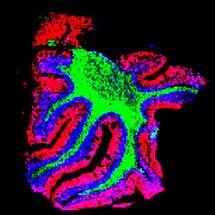PET imaging detects fast-growing prostate cancer
A molecular imaging biomarker is able to detect fast-growing primary prostate cancer and distinguish it from benign prostate lesions, addressing an unmet clinical need. The new research, published in The Journal of Nuclear medicine, is significant for patients with suspected prostate cancer that has not been confirmed by standard biopsy.
"We were able to demonstrate in our research that PSMA PET imaging was more specific than MR imaging for detection of clinically significant high-grade prostate cancer lesions, and importantly was able to distinguish benign prostate lesions from primary prostate cancer, currently a difficult diagnostic imaging task," stated Steven P. Rowe, MD, PhD, resident at Johns Hopkins Medical Institutions in Baltimore, Md. "Additionally, this work demonstrated a direct correlation between PSMA PET radiotracer activity in prostate cancer and prostate adenocarcinoma aggressiveness (Gleason score)."
The study enrolled 13 patients with primary prostate cancer who were imaged with F-18 DCFBC PET prior to scheduled prostatectomy, with 12 of the patients also undergoing pelvic prostate MR imaging. Prostate 18F-DCFBC PET was correlated with MR imaging and histologic and immunohistochemical analysis on a prostate-segment (12 regions) and dominant-lesion basis. There were no incidental extraprostatic findings on PET suggestive of metastatic disease.
Results showed that MR imaging was more sensitive than 18F-DCFBC PET for detection of primary prostate cancer in a per-segment (sensitivities of 0.17 and 0.39 for PET and MR imaging, respectively) and per-dominant (sensitivities of 0.46 and 0.92 for PET and MR imaging, respectively) lesion analysis. However, 18F-DCFBC PET was more specific than MR imaging by per-segment analysis (specificity of 0.96 and 0.89 for PET and MR imaging for non-stringent analysis and 1.00 versus 0.91 for stringent analysis, respectively) and highly specific for detection of high-grade lesions greater than or equal to 1.1 mL in size (Gleason 8 and 9).
Steve Y. Cho, MD, associate professor at the University of Wisconsin School of Medicine and Public Health states that the findings contribute to the importance of PSMA-based PET imaging for detection and characterization of the biology of the prostate cancer. "There are a number of PSMA-based PET agents currently being introduced into prostate cancer imaging, many with improved signal to background uptake and sensitivity from this earlier first-generation PSMA 18F-DCFBC PET radiotracer, which should further improve the detection of prostate cancer," he continues. "While it is difficult to predict which of the numerous prostate cancer molecular imaging agents being developed will ultimately become clinically adopted, this work, in aggregate with that of other groups, suggests there are important advantages to the PSMA ligands for prostate cancer molecular imaging."
Organizations
Other news from the department science

Get the life science industry in your inbox
By submitting this form you agree that LUMITOS AG will send you the newsletter(s) selected above by email. Your data will not be passed on to third parties. Your data will be stored and processed in accordance with our data protection regulations. LUMITOS may contact you by email for the purpose of advertising or market and opinion surveys. You can revoke your consent at any time without giving reasons to LUMITOS AG, Ernst-Augustin-Str. 2, 12489 Berlin, Germany or by e-mail at revoke@lumitos.com with effect for the future. In addition, each email contains a link to unsubscribe from the corresponding newsletter.
Most read news
More news from our other portals
Last viewed contents
European Approval Granted for Two Phase Ib Clinical Trials of Bionomics' BNC210 - First trial will evaluate the potential for BNC210 to relieve panic attacks and reduce symptoms of anxiety




















































